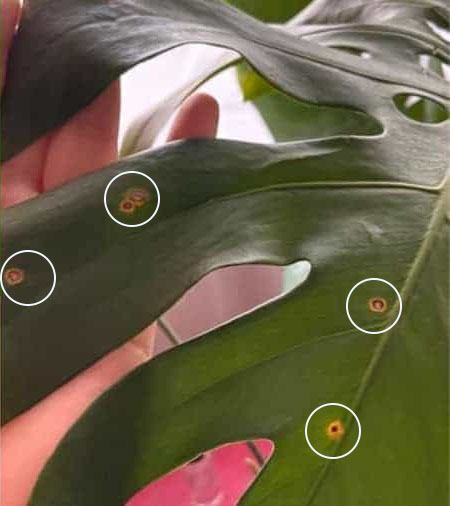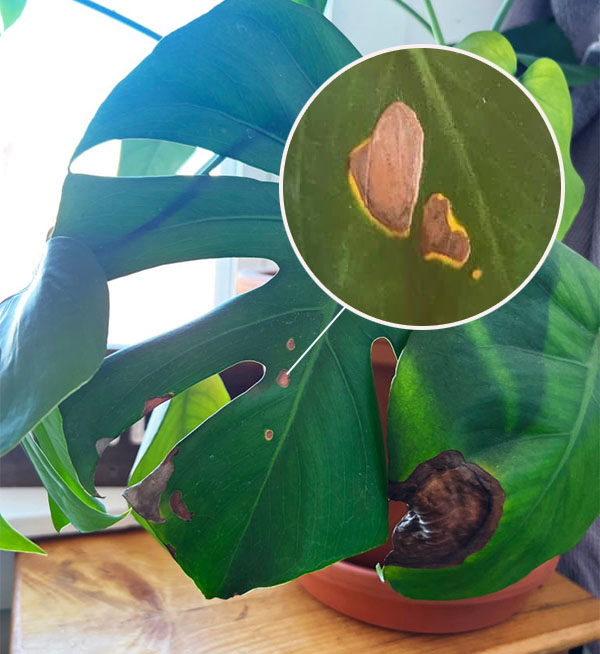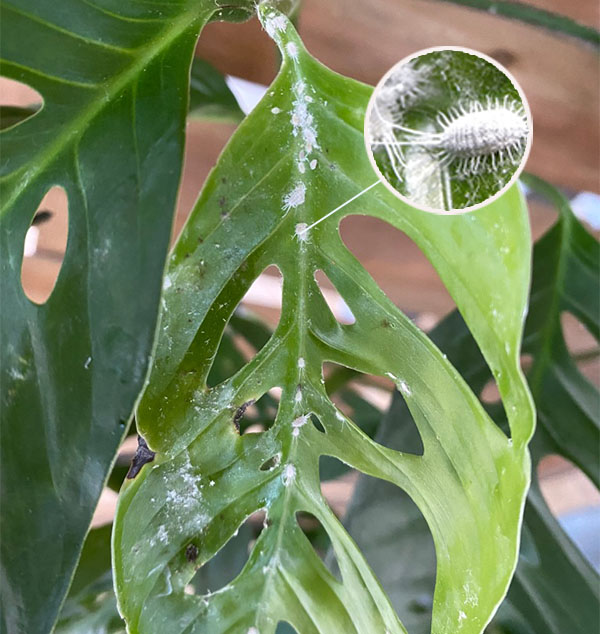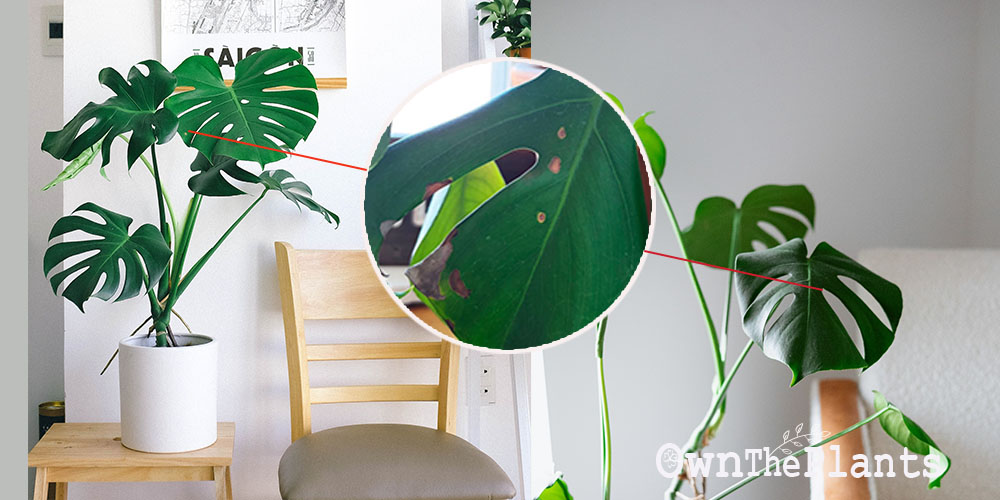It does put you off when you see flaws in something you worked hard for to be pristine and perfect, right?
The same can be said about having brown spots on your gorgeous Monstera plant that you thought you had taken good care of.
However, you should not solely put the blame on yourself for having sickly Monstera leaves. The reasons could be random, and most of the time, they are the ones that are easily overlooked.
Worry no more! In this article, we will help you understand the main reasons why your Monsteras have these dreadful brown spots.
And, of course, we will give you solutions so that you can save your dashing plants before it is too late.
How to Identify Your Monstera’s Brown Spots?
Monstera’s brown spots can be caused by a lot of things, may it be environmental or just caused by improper care.
No matter the cause, the first course of action should be to identify the spots to know the real problem. However, this step can be tricky since a lot of causes have specific conditions to them.
To help you with your problem, here is a guide on how to properly observe the brown spots and what to look for if your Monstera plant is suffering from this problem.
How Do They Look?
Like any kind of plant problem, the first thing you must do is identify the problem, observe how it manifests on the plant, and try to see if it is only isolated in one plant part or to the whole plant. This way, you can efficiently deduce what’s the next best thing to do.
When you observe brown spots on your Monstera plants, you must familiarize yourself with their appearance on the foliage.

Try to take note of its color, shape, size, and other observable characteristics.
Usually, the colors of the spots appear to be a darker shade of brown to black. Oftentimes, they appear reddish or tan that have yellow rings around.
Spots are usually rounded, but they also come in irregular shapes. Sizes also depend on the damage to the leaf surface.
Don’t be surprised if you see some leaves with brown spots falling off from the stem. Affected leaves are usually necrotic.
This is an indication that the infection is quite heavy and needs to be addressed immediately.
What portions of your Monstera are infected?
The lower canopy of your Monstera plants is usually susceptible to brown spots. It is because areas that are extremely shaded are more susceptible to brown spot problems.
Both the undersides and the uppersides of the leaves can be affected. In worse situations, sometimes both sides of the leave are simultaneously affected, depending on the extremity of the problem.
What Are The Causes of Brown Spots on Monstera?

The brown spots of your Monstera plant can be caused by a lot of things.
Depending on how it appears on your plant, the spots can be due to excessive light, unfavorable temperature and humidity, water problems, fertilization, and in usual cases, pests and diseases.
Learning how to identify which causes your problem is a must for a plant lover. To help you understand more about the brown spots of your Monstera, consider the different factors below:
Excessive Light
Like how your skin gets tanned and painful after getting too much exposure to sun, your plant also experiences this, too, although in a different way.
The UV light is not just harmful to us, humans, but also to all organisms as well, including your plants.
When light is excessive, plant cells burn, resulting in scattered brown spots on the leaf surface. The size of a scorched plant surface depends on how damaged the cells are.
Remember that two factors of light lead to scorching – quality and quantity. The first one refers to excessive light intensity, and the other one is excessive exposure.
Unfavorable Temperature and Humidity
Even though your plant hails from the sunny tropics, an extremely hot and dry environment can make your Monstera suffer.
If left in these hot conditions for too long, the leaves will develop brown spots until they get full brown, dry, and crispy.
On the other hand, when the temperature is extremely cold, your Monstera leaves can develop chill spots due to contact with windows or cold drafts. These spots will eventually become brown.
Improper Watering
Every plant enthusiast must know how to sufficiently water each plant they own.
Each plant differs in how they need water; thus, watering is a tricky chore. You must know how much water is needed and when a plant needs watering.
Overwatering is one of the causes of brown spots on your Monstera. When a soil is extremely soaked, water and nutrient transport by the roots are comprised.
Hence, your plant is not getting the essentials it needs to thrive. This leads to the appearance of brown spots in your plant. If not remedied, the leaves will eventually turn yellow.
On the other hand, underwatering also cause brown spots on the leaves. Water deficiency leads to leaf scorching, which is more apparent on the margins.
Drought stress causes cells to die, leading to brown spots appear on the leaves.
Water Quality
Like light, quantity and quality of water affect your plant’s health. We’ve tackled the effect of improper quantity of water on plants, so now, we will delve into the effect of having impure water.
Water quality affects the plant in various ways. Water that’s contaminated previously with pathogens can infect your Monstera plant. More so, a high salt content water can also induce saline stress to your plant.
Excessive salt content will impair your plants ability to absorb water from soil. This will eventually lead to plant cells shrinking and dying.
One symptom of saline stress is brown leaf tips with red to brown spots on the outward margins of leaves.
Pest Problems
Pests are common plant problems. They just love munching on foliage and sucking juices from plant tissues.
Unfortunately, they leave wounds that look exactly like brown spots. Without intervention, they deal extreme damage to plants.

Common pests of your Monstera include mealy bugs, thrips, spider mites, scales, and gnats. When you see brown spots on the leaves, immediately find any signs of their presence.
Disease Problems
Pathogens such as bacteria, fungi, and other microorganisms can also be the possible reasons for the brown spots on your Monstera plants. Plants usually get these organisms from water or air and the diseases they cause commonly appear as spots in various sizes.
Once they settle on your plant’s leaves, they eventually start reproducing. In an optimum environment, leaf spots will appear in just one to two weeks after infection.
You might also like: Why Are My Chinese Evergreen Leaves Yellow? (9 Causes + Fix)
How Do You Treat Brown Spots on Monstera?
Now that you know the several factors that could be the reason why your Monsteras are suffering from brown spots, we will now help you treat them.
Of course, the treatment varies depending on the cause.
Here’s how you can help your lovely Monstera overcome its leaf spots problem.
Give Proper Quality and Quantity of Light
If you are certain that the brown spots of your plant is caused by incorrect light conditions, fix this problem by relocating your plant to a space with optimum sunlight. Do not let your Monstera to be exposed to direct sunlight for too long.
An indirect light is sufficient for your plant to undergo photosynthesis, so there is really no need to expose them in harsh conditions. Doing so will just give your plants stress.
Prepare for Changing Seasons
As they all say, prevention is better than cure. To prevent this problem due to temperature reasons, prepare beforehand for cold and hot days.
We can’t stop the changing of time, but we can prevent our plants from being sick.
Especially during summer season, a working air condition will greatly benefit your plant.
Indoor ventilation or humidity enhancer, like your humidifier, will cool down the environment, and thus making your plants happy and thriving. The added coolness will alleviate heat stress from plants.
More so, insulation also helps the plant during the winter season. Make sure to designate a location of your plant indoors that will save them from having chill spots.
Control Application of Water
If water is the main cause of the problem, then you must control how you apply water to your plants. Depending on the reason, rectify your routine to suit the plant’s needs properly.
As a general rule, check the soil first before watering. A dry and cracky soil is a sign that your plant needs to be watered.
However, if the top two to three inches of soil are still moist, your plant can benefit from a skip of watering. Wait until the soil becomes dry before you water your plant.
When overwatering is the problem, dry your plant first by exposing it to moderate light to help evaporate the excess water faster.
If underwatering is the cause, water your plant immediately. Drip irrigation can be done to ensure water reaches the soil’s bottom.
Use Clean Water
Water is an efficient medium to spread pathogens and harmful chemicals thus, ensuring your water is clean is very important.
If your plant is experiencing problems due to impure water, stop using this water and find another source elsewhere.
If you’re unsure about tap water quality, it is better to start saving rainwater. Unlike your tap water that is chemically treated already, you can be sure that rainwater is free from harmful chemicals so plants will surely benefit from them.
Manage Pests ASAP
Pests multiply quickly; hence, they must be eradicated at first sight.
If the infestation is still minor, manually remove the pests. Prune out the damaged foliage as well to prevent them from spreading.
However, if the damage is already extreme, utilize a pesticide to eliminate them. Always be careful in applying these chemicals.
You can also try organic, DIY pesticides at home if you want to save cash.
Remove Infected Plant Parts ASAP
Spreading the disease to other plants is the last thing we want to see. Discard the infected plant parts and isolate at once the infected Monstera.
This is to ensure you avoid cross-contamination to the rest of your garden.
You can burn these leaves or treat them first with fungicides before burying them away from your garden.
Also, don’t forget to clean the tools you used. Treat your plant with fungicides and bring them back to your garden only when they have fully recovered.
Final Thoughts
How your plant appears is a reflection of its health. When you have a plant that has a dull appearance, expect that there is something wrong with it. Your plant will always let you know when it needs tending to.
If your Monstera plant is suffering from brown spots, investigate at once to know what causes it and also for you to act on it properly. As you now know, different causes require different fixes.
If you find this article helpful, we will surely appreciate it if you let us know in the comment section below. Here’s to healthier and livelier Monstera plants!
